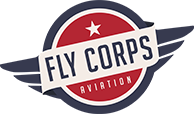
Getting started
At Fly Corps, we're thrilled to guide you on your journey to becoming a pilot! Begin your adventure by filling out the Student Enrollment Form linked on the button below. Next, if you have no prior training, we will help you schedule a discovery flight! This experience will introduce you to our experienced instructors, modern facilities, and most importantly, what it’s like to fly!
Simultaneously, ensure you meet the necessary medical standards by obtaining your aviation medical certificate through an Aviation Medical Examiner (AME). As you prepare for this, dive into studying for the theoretical knowledge tests which are integral to your training. Our team at Fly Corps offers tailored ground school courses and recommended study materials to support your preparation.
Establishing a consistent training schedule with us is key to maintaining momentum and optimizing your learning experience. At Fly Corps, we are committed to fostering your passion for aviation and guiding you every step of the way toward achieving your pilot's license. Together, let's soar towards your dreams with confidence and expertise.
-
The age requirements for each certificate are:
Student Pilot
16 Years Old
A Student Pilot Certificate allows you to fly with an instructor, and solo (no passengers) with the proper endorsements.
Private Pilot
17 Years Old
A Private Pilot Certificate allows you to fly for recreation and personal travel.
Commercial Pilot
18 Years Old
A Commercial Pilot Certificate enables you to fly for compensation or hire.
Airline Transport Pilot
23 Years Old
-
First, determine the medical certificate class you will require. FAA Medical Certificates are categorized into three classes:
First Class
Required for airline transport pilots; have the strictest medical standards, including vision, hearing, cardiovascular health, and require more frequent renewal (every 6 months to 1 year).
Second Class
For commercial pilots and flight instructors; are slightly less stringent, with renewal every 1 to 2 years.
Third Class
For private and recreational pilots; are the least strict, with renewal typically every 2 to 5 years.
Choosing the right class ensures pilots meet the appropriate health requirements for their flying privileges.
Once you have determined the medical certificate class you will need, you can schedule your exam with any Aviation Medical Examiner (AME).
The FAA provides a tool to find one near you: Locate an AME
Perfect vision isn't required, but it must be correctable to 20/20 in each eye. There are also specific standards for color vision depending on the type of pilot license you're pursuing.
-
The time varies depending on factors like your availability for training, weather conditions, your funding, and the type of license you're pursuing.
Generally, you can obtain a Private Pilot Certificate in as little as a few months!
-
Part 141 and Part 61 refer to two distinct sets of regulations established by the Federal Aviation Administration (FAA) in the United States for pilot training.
Part 141 Flight Training:
Part 141 flight training is conducted through an FAA-approved flight school or training center.
The curriculum and training syllabus are standardized and approved by the FAA.
Flight instructors must meet specific qualifications set by the FAA.
Part 141 training typically involves more structured, organized, and regulated training programs.
Requires fewer flight hours to qualify for certain pilot certificates or ratings compared to Part 61.
Part 61 Flight Training:
Part 61 flight training can be conducted through any FAA-certified flight instructor, flight school, or independently.
The training is based on individualized student needs and progress.
There is more flexibility in the curriculum and training schedule, allowing for customization based on student preferences and progress.
Part 61 training may require more flight hours to qualify for certain pilot certificates or ratings compared to Part 141.
Basically, while both Part 141 and Part 61 flight training lead to the same pilot certificates and ratings, they differ in terms of structure, regulation, and flexibility. Choosing between them depends on individual preferences, learning styles, and training objectives.
